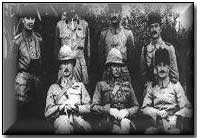Battles - Samarrah Offensive, 1917
 Fresh from his success in
securing the fall of Baghdad,
regional British Commander-in-Chief
Sir Frederick
Stanley Maude barely paused before launching an offensive further north to
consolidate the new Anglo-Indian position at Baghdad, at present threatened by
some 10,000 troops to the north of the city.
Fresh from his success in
securing the fall of Baghdad,
regional British Commander-in-Chief
Sir Frederick
Stanley Maude barely paused before launching an offensive further north to
consolidate the new Anglo-Indian position at Baghdad, at present threatened by
some 10,000 troops to the north of the city.
Thus the Samarrah Offensive - incorporating the Battle of Istabulat - was launched with 45,000 frontline troops in mid-March 1917 and ran for approximately six weeks before operations were effectively called off until the autumn.
Maude's Turkish opposite, Khalil Pasha, possessed 10,000 troops to the north of Baghdad. He also relied upon imminent reinforcement by Ali Ishan Bey's 15,000 troops presently retreating from Persia at the hands of the Russians.
Maude determined that no further significant offensive could be considered until his Anglo-Indian force had seized control of the Samarrah railway, some 130km north of Baghdad.
In planning to capture Samarrah Maude devised a four-pronged plan: to initiate a series of small-scale attacks up the River Tigris; to prevent deliberate Turkish flooding of the plains around the Euphrates River; to prevent Ali Ishan Bey's force of 15,000 from rendezvousing with Khalil; and to conduct holding operations in the west.
 In
the event the Turks fought with tenacity against Maude's advance once it was
underway. Operations began on 13 March -
just two days after Baghdad itself fell to the British - with a successful raid
on Turkish lines a little north of the city, obliging a Turkish 35km retreat to
the junction of the rivers Tigris and Adhaim.
In
the event the Turks fought with tenacity against Maude's advance once it was
underway. Operations began on 13 March -
just two days after Baghdad itself fell to the British - with a successful raid
on Turkish lines a little north of the city, obliging a Turkish 35km retreat to
the junction of the rivers Tigris and Adhaim.
A little under a week later, on 19 March, Falluja was seized, crucially preventing the Turks from flooding the plains and significantly harassing the British advance.
Six days later however, on 25 March, an attempt to encircle Ali Ishan Bey's 15,000 men was emphatically repelled; the latter was able to move west to meet up with 5,000 Turkish troops at Dogameh sent down the Tigris to meet him. Maude's attempt to prevent the meeting - by despatching cavalry and launching infantry attacks upon Dogameh - was ultimately successful, if costly, Dogameh being taken on 31 March.
As a consequence of the action at Dogameh the Turkish defence fell back to the Tigris/Adhaim Rivers junction. The British, under General William Marshall (Maude's eventual successor as regional Commander-in-Chief following the latter's death in November 1917), promptly attacked the fresh Turkish position on 18 April (after a hasty detour to assist besieged cavalry at Shiala).
Having by now withdrawn a further 35km north to Istabulat, Khalil's force retired to formidable positions between the Tigris and the Al Jali Canal; the Samarrah railway itself lay in-between.
 Undeterred
by the scale of the task Maude continued with the offensive on 21 April,
attacking at various points near to the river.
Undeterred
by the scale of the task Maude continued with the offensive on 21 April,
attacking at various points near to the river.
Heavy fighting saw some positions switch sides several times, until on the following morning the defending Turks retreated once again, this time to a ridge barely 10km from the railway. Casualties were roughly equal, at 2,000 apiece.
Continuing British attacks - and with more reserves on the way - persuaded the Turks to cede Samarrah on 23 April, leaving the town - and its railway - in British hands.
Successful in that it attained its aim the Samarrah Offensive nevertheless proved highly costly to the British. Casualties in the offensive as a whole were estimated at around 18,000, although a further 40,000 were lost to sickness.
The scale of such losses obliged Maude to pause and regroup pending a further advance in the autumn. Just as significantly the relative numerical weakness of Maude's force meant that no redirection of resources to the Western Front could be seriously considered. The desire of the War Office in London (notably Sir William Robertson) to scale down operations in Mesopotamia remained unfulfilled.
Click here to view a map charting operations at the time of the fall of Baghdad.
Actions and Engagements of the Offensive
| Battle | Date |
|---|---|
| Seizure of Falluja | Opened 19 March |
| The Battle of Jebel | Opened 25 March |
| The Battle of Shiala | Opened 11 April |
| The Battle of Istabulat | Opened 21 April (this document) |
| The Battle of the Boot | Opened 30 April |
Photographs courtesy of Photos of the Great War website
'minnie' was a term used to describe the German trench mortar minnenwerfer (another such term was Moaning Minnie).
- Did you know?
